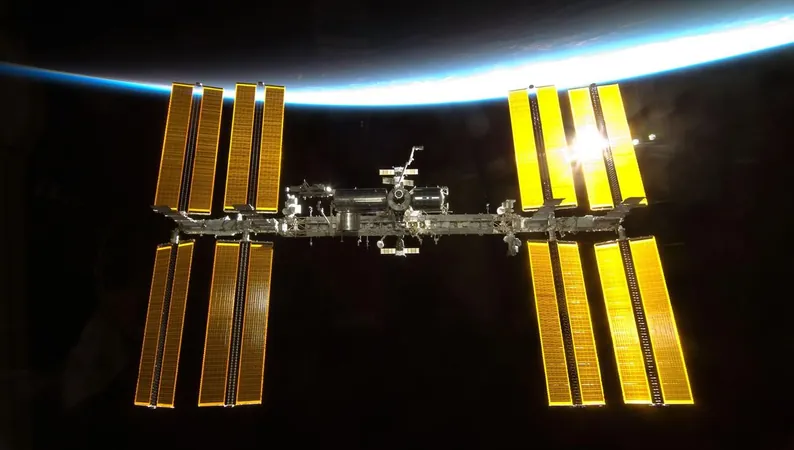
Major Threats to the Aging ISS: NASA's Alarming Findings Revealed!
2024-10-29
Author: Li
Introduction
As of Saturday, November 2, humans have resided continuously in the International Space Station (ISS) for an incredible 24 years, marking a significant milestone in space exploration. However, this aging marvel is now facing some serious challenges as its operational capabilities are stretched. The ISS is currently set to operate until 2030, with plans for deorbiting in 2031, but a recent audit has highlighted risks that could jeopardize this timeline.
Current Risks
While astronauts and cosmonauts currently aboard the ISS are not in immediate peril, the long-term safety of the station is at stake. Increasing concerns have emerged regarding cracks and air leaks, particularly from the Russian segment. Just a few months ago, NASA reported a concerning peak in atmospheric loss, pointing to potential issues within the station's structure.
According to the report, "Ongoing cracks and air leaks in the Service Module Transfer Tunnel are a top safety risk." NASA and Roscosmos, the Russian space agency, are teaming up to investigate these vulnerabilities, striving to pinpoint the root causes while staying vigilant for new leaks. Unfortunately, as of April 2024, NASA identified that the leak rate had surged to the highest level observed to date.
Recent Mitigation Efforts
Over recent months, efforts have been made to seal numerous areas identified as concerns, totaling around 50. While some of these might have simply been cosmetic scratches, the threat of serious leaks is very real. Interestingly, not all leaks stem from wear and tear; the ISS has faced threats from space debris, highlighted by an incident where a micrometeoroid damaged a Russian Soyuz Capsule, leading to a coolant leak and an extended stay for the astronauts aboard.
Budget Constraints and Safety Measures
What's even more alarming is that NASA has been compelled to take inherent risks with micrometeoroids and orbital debris due to escalating costs associated with protective upgrades. To bolster safety measures, the agency is enhancing its capabilities for tracking orbital debris, allowing for better monitoring of potential threats.
Evacuation Protocols
Another critical aspect discussed in the report touches on the astronauts' evacuation protocols. While there are plans in place to ensure crew safety during emergencies, the existing evacuation spacecraft might not suffice in extreme scenarios. Tight budgets and a lack of readily available vehicles mean that if significant damage occurs, NASA could struggle to respond effectively.
Geopolitical Tensions and ISS Outlook
The timeline for the ISS's future is also under scrutiny. This collaborative project between NASA and several international space agencies, including Roscosmos, is complicated by geopolitical tensions. Following Russia's invasion of Ukraine, Roscosmos hinted at withdrawing from the ISS to develop its own station, leaving the future of the ISS hanging in limbo. Despite this, the other space agencies are committed to keeping the ISS operational until at least 2030.
Delays in Space Initiatives
Compounding these challenges are delays in other space initiatives, including plans for private space stations and the Gateway lunar orbiting platform. With spacecraft like SpaceX’s Starship experiencing setbacks, NASA may be faced with prolonging the ISS’s service beyond 2030. This extension could present significant challenges, including the need for repairs and sourcing outdated components, further strained by looming supply chain issues.
Deorbiting Complications
Finally, the deorbiting of the ISS presents its own set of complications. The current plan relies heavily on Russia's Soyuz program. A lack of commitment from Roscosmos raises questions about the feasibility of a controlled descent. To address this, NASA has contracted SpaceX to develop a U.S.-based deorbit vehicle; however, uncertainties surrounding commercial destination readiness and budget constraints threaten the viability of this plan.
Conclusion
The ISS's contributions to science and international cooperation over these past 24 years cannot be overstated. Yet, this report underscores the critical issues that must be urgently addressed if the station’s mission is to continue successfully. The challenges of maintaining a human presence in space are far from easy, and the future of the ISS hangs precariously in the balance. Buckle up – the next few years will be crucial!





 Brasil (PT)
Brasil (PT)
 Canada (EN)
Canada (EN)
 Chile (ES)
Chile (ES)
 España (ES)
España (ES)
 France (FR)
France (FR)
 Hong Kong (EN)
Hong Kong (EN)
 Italia (IT)
Italia (IT)
 日本 (JA)
日本 (JA)
 Magyarország (HU)
Magyarország (HU)
 Norge (NO)
Norge (NO)
 Polska (PL)
Polska (PL)
 Schweiz (DE)
Schweiz (DE)
 Singapore (EN)
Singapore (EN)
 Sverige (SV)
Sverige (SV)
 Suomi (FI)
Suomi (FI)
 Türkiye (TR)
Türkiye (TR)